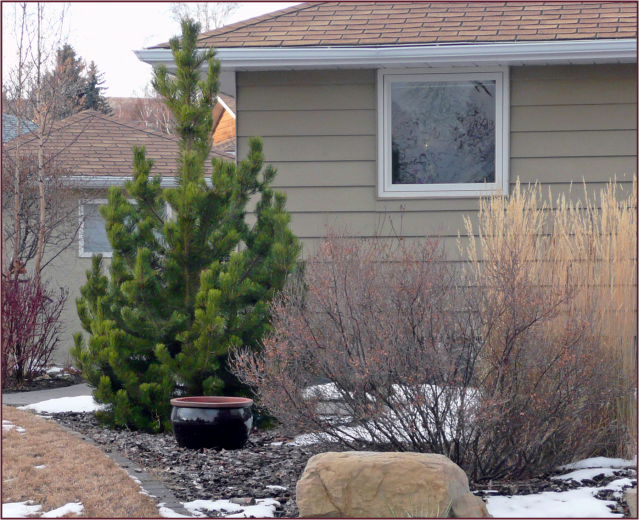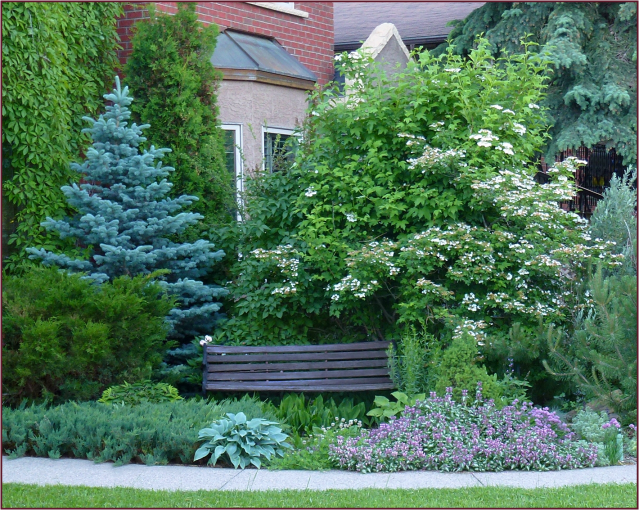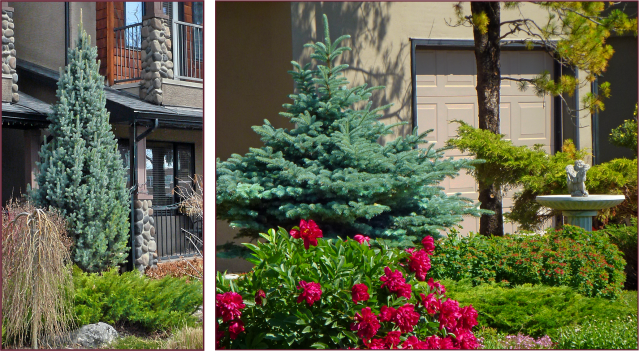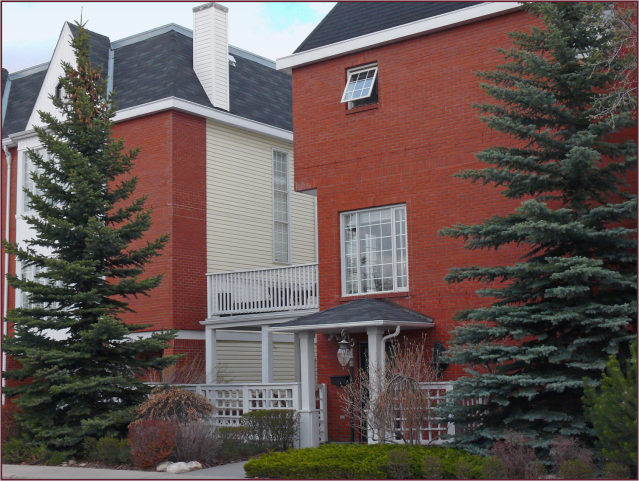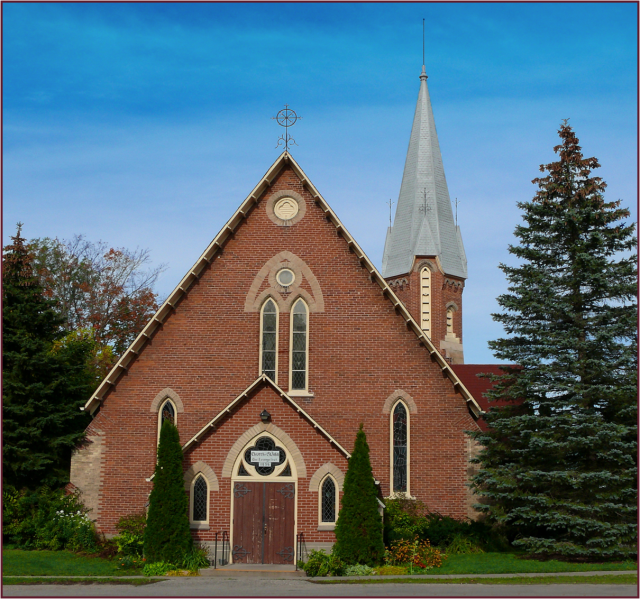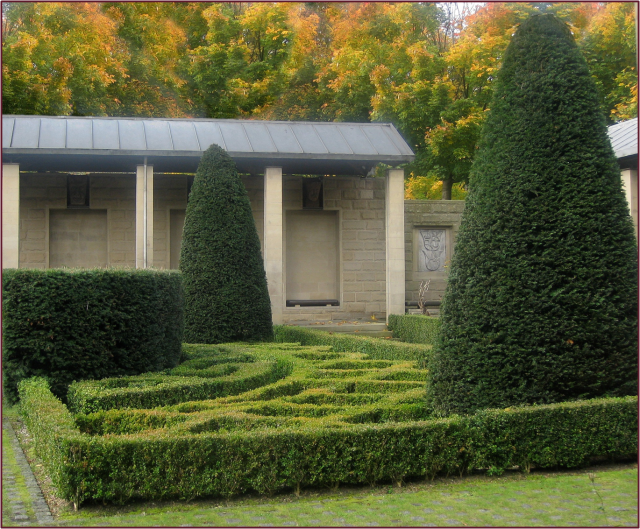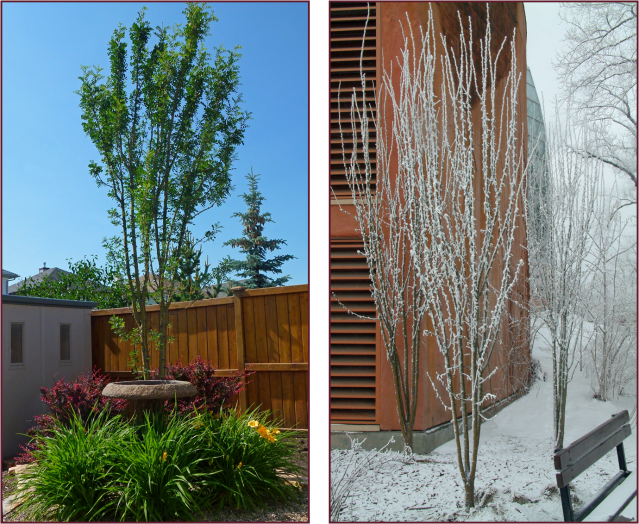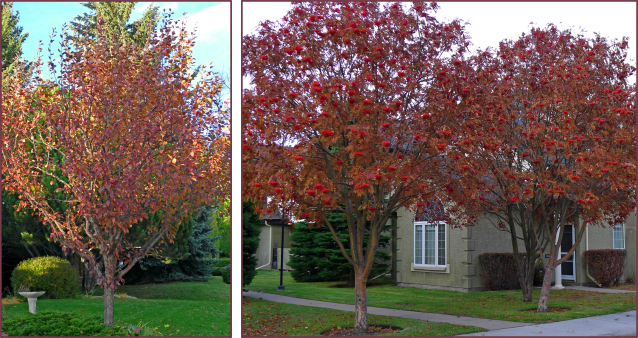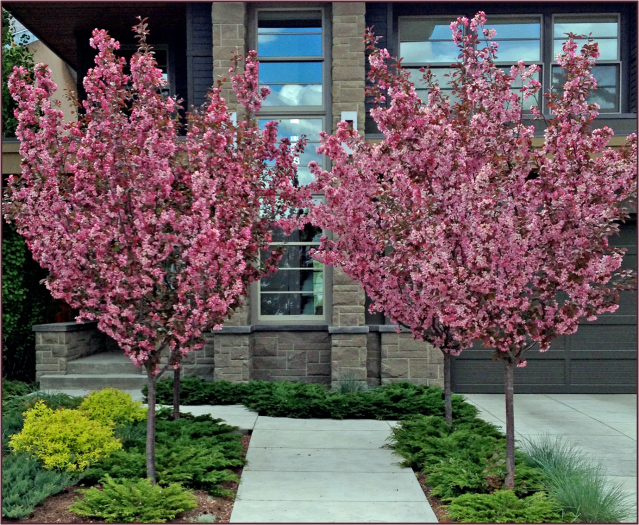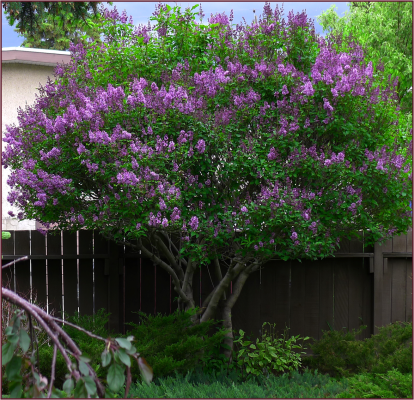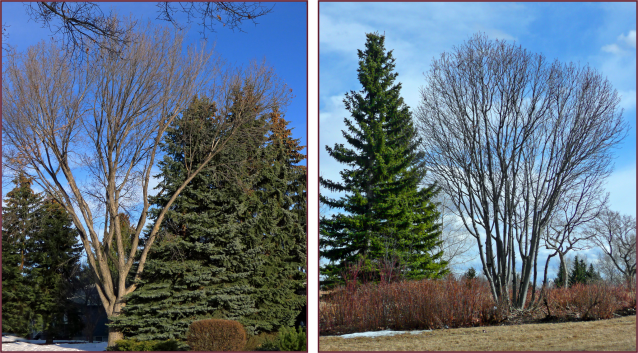O Christmas tree, O Christmas tree,
How lovely are thy branches.
Not only green when summer’s here
But in the coldest time of year.
O Christmas tree, O Christmas tree,
How lovely are thy branches.
Nothing says Yuletide quite like evergreen boughs, whether still on the tree, or as part of some other seasonal ornamentation. Almost every home at this time of year has the requisite evergreen wreath, swag, garland, or container arrangement. I myself dabble only in the latter; the seasonal container.
I didn’t always participate in this Christmas container frenzy – mixed evergreen branches billowing over the tops of pretty pots, complete with festive balls and bows. It all seemed a bit artsy-crafty to me. But I had to admit, a tasteful arrangement could enhance the overall appeal of a winter landscape. In time I learned to embrace my “inner Martha”, though I soon discovered that arranging evergreen boughs in a winter container required a different skill-set than designing a landscape, a garden, or a summer container arrangement. No this required a florist’s flair, a talent this garden designer is decidedly lacking.
My early attempts weren’t particularly spectacular – spruce and juniper branches harvested from trees and shrubs in my garden, with a few dogwood stems sprinkled in. They were a bit drab actually – not surprising since many spruce and juniper species tend to lose colour saturation in our very cold winters, becoming dark and dull. In containers their presentation is therefore lacklustre. Pine however, stays delightfully green, cedar too – I tried those, but apparently any old pine or cedar won’t do. My garden gatherings of stiff upright mugo pine branches and sprigs of Emerald Green cedar just didn’t do the trick. Something with a more draping habit was needed.
Eventually, about the 23rd of December one year, knowing we’d be entertaining family the following night, I decided I should really purchase some suitable greenery. I live only a few minutes away from several greenhouses, so off I went in search of greener greens. Fortunately, since it was so close to Christmas, everything was discounted – which also meant of course, that selection was limited. There was still some fir to be had, and one scruffy bundle of pine. A gentlemanly sales attendant scrounged up a few cedar boughs for me. I needed something taller too, for height and structure. All that was left was some twiggy, tawny-hued huckleberry branches – this would have to do I guess. I plopped my greenhouse finds into my containers, fussed with them a bit, then fussed some more. The end result was… well, acceptable.
I continued with these last-minute arrangements for a number of years – they were attractive enough, but I certainly wouldn’t say I’d found my calling. And no festive balls or bows – this was definitely still too Martha Stewart for me.
I guess we must have had mild autumn temperatures that extended well into December, or maybe very timely Chinooks, because in all those years I whipped up my eleventh-hour Christmas containers, not once was the soil in my ceramic pots frozen… until last year. This was the year I decided to shop early for Christmas greens so I’d have lots to choose from. I was like a kid in a candy store. Beautiful bunches of fir and hemlock, soft pine, lacy cedar and elegant cypress, rich red dogwood stems, pretty berried branches and crisp white birch branches – I bought it all, hundreds of dollars worth.
The plants from my summer arrangements were still in the pots, covered in snow (winter had come early) and had to be removed before I could do my holiday arrangement. “No problem,” I thought, “I’ll get my trowel and quickly pop out the dead plants.” Clunk. Metal hit ice. Hmmm. “No problem,” I thought, “I’ll get some warm water and melt the frozen soil and then with my trowel pop out the dead plants.” Scrape, scrape, scrape – the warm water thawed enough soil for me to remove about a teaspoonful. More warm water, more scraping, another teaspoonful of soil removed. This was not going to work. Hmmm. “No problem,” I thought. I went inside and got my blow-dryer. “I’ll blow hot air on the frozen soil to melt it and then with my trowel I’ll pop out the dead plants.” Whirrrrr. Whirrrrr. Whirrrrr. There I was sitting on my front steps, in sub-zero temperatures, bundled up like a snow-suited child, attempting to melt a huge block of ice-soil with a blow-dryer. The neighbours must have had a good chuckle at the sight. Unfortunately, the hot air wasn’t making any difference. My hands were freezing. Feeling foolish and very frustrated, I gave up and went inside.
“How’s it going out there?” asked my husband as I came in the front door. The look on my face answered his question. Not well. What was I going to do with all the beautiful greenery I’d purchased? There was no way those pots were coming inside to thaw – they were way too heavy. When I first bought them I was concerned that, being such pretty pots, someone might walk off with them – so I filled the bottom half with sand and gravel. Nope, nobody was going to move those babies – ever.
“I have an idea” Hubby said. I didn’t want to hear his idea. I wanted to pout and throw a hissy-fit. But I remembered what I’d always told my kids when they were young and something would go wrong: “You need to get out of flip-out mode and get into problem-solving mode,” I’d chirp. So I listened to my husband’s idea. We had some reasonably attractive plastic pots on the back patio – they were painted black but finished to look like burnished bronze. While the soil in these pots was also frozen solid, they weren’t so heavy and could easily be carried inside to thaw. It was a good idea; better than anything I had come up with.
It took at least 2 days for the soil in the plastic pots to thaw, but once it was workable I went to work poking the myriad of branches into the soil. First the birch branches for height and structure. Then the bendy cedar and cypress boughs which would drape over the edges. Then the more rigid fir and hemlock branches, and finally the dogwood stems and red-berried branches for colour. But still no festive balls or bows.
We carried the two pots outside and placed them in front of the unusable ceramic pots. They looked pretty impressive – impressively large anyways; so large that the evergreen boughs impeded access somewhat to the front door. Perhaps I’d purchased more container ingredients than I needed.
This year I got smart – I made sure I removed the summer arrangements from my containers well before freeze-up. I also removed about a third of the soil so I could add fresh topsoil in which to arrange my evergreens and accoutrements.
A few weeks ago I espied some pretty potted arrangements when driving by a large department store (which I shall not name because I don’t want to give them free advertising). What caught my eye in these holiday arrangements was, I’m embarrassed to say, the beautiful copper-coloured festive balls and bows. I couldn’t stop thinking about these lovely rich-hued ornaments and visualizing how pretty they’d look in my earthy-coloured ceramic pots against the café-au-lait colour of my house and the chocolatey colour of my front door and wrought iron railings. So I went back and bought them.
Originally the idea was to take everything out of the store-bought plastic pots and rearrange in my own pots. However, the plastic pots fit nicely into the mouth of my tear-drop-shaped containers – so there they stayed. I know, I know, for a garden designer this was shamefully lazy, cheating even. It never pays to cheat though, because the next day all the evergreens in one of the store-bought arrangements had turned brown, despite watering as directed. I returned it to the store-which-won’t-be-named, and to their credit, they happily exchanged it for one that still looked alive.
The weather turned nasty a day or two later and my holiday arrangements were soon covered in snow – it was very pretty and Christmassy, but the evergreen boughs turned suspiciously crispy in the frigid cold. I had a feeling they wouldn’t look so good when the temperatures rose again with the next Chinook. Indeed when the Arctic front blew out and a Chinook blew in, my evergreens became everbrown. Sigh. It was now past the middle of December and I was running out of time – and patience. I brought the pots inside and tried to pull out the dead stuff – they wouldn’t budge. I examined the centre of the arrangements to see what was holding everything so tight. It was florist’s foam. Very frozen florist’s foam. Sigh….
After a day or two the foam thawed. I poked some fresh pine branches and cedar boughs into it and some reddish twiggy things from an indoor vase which I bundled together to add height. My backyard containers hadn’t been cleaned out yet and still housed clumps of coppery sedge (Carex comans ‘Bronco’) – it was dead but still had some colour and made a pretty addition to my Christmas arrangement. A few sprigs of blue spruce, the copper ornaments from the store-bought pots, and my holiday containers were done. It was night-time when I placed my newly created evergreen arrangements into the ceramic pots – from what I could see in the dark they looked okay; better than the prearranged ones I’d purchased and certainly better than any of my previous attempts.
The following morning, seeing that it had snowed over night, I offered to relieve Hubbie of front-walk-shoveling duty. My new Christmas containers were dusted in snow. The now white-capped copper ornaments sparkled in the sun. As I moved down the walkway piling snow this way and that, I looked back towards the house and noticed that from this vantage point the black plastic pots were visible above the ceramic pots. “That looks tacky,” I said to myself. Thinking I hadn’t placed them properly, I attempted to adjust them, but to no avail. I guess the fit wasn’t as good as I thought when I first popped them in there. Sigh. My work was still not done.
I considered my options and determined they were limited. The foam was frozen again so I couldn’t just poke more drapey branches in. I thought about taking the foam out of the plastic pots and placing the whole arrangement right inside the ceramic pots, but one of the chunks of foam had split in half when I was manhandling it trying to remove dead evergreens. I was afraid without the pot to hold the foam together that everything might fall apart. I decided my best option was to drill holes through the side of the pot into the frozen foam and stick more evergreen boughs in the holes. My husband brought me his battery operated drill and showed me how to use it. Bzzzz. Bzzzz. Bzzzz. There I was again, sitting on my front steps, in sub-zero temperatures, bundled up like a snow-suited child, this time drilling holes into my pots – more entertainment for my neighbours I’m sure. I didn’t last long in the cold though, so I brought the pots inside and finished my drilling and poking in the basement. I soon became very adept with the drill, exchanging drill bits from small (to puncture the pot) to large (to fit branches in) with a few quick flicks of the wrist. That’s right, this girly girl was using power tools. For some reason Hubbie found this very amusing, attractive even.
So in the end I did create some not-too-bad looking Christmas arrangements….

 My latest container attempts – I don’t have the flair of a florist, but aren’t the colours pretty? Photos: Sue Gaviller
My latest container attempts – I don’t have the flair of a florist, but aren’t the colours pretty? Photos: Sue Gaviller
So now that y’all know what not to do when creating your Christmas arrangements, it’s only fair I provide some examples of really well done containers. Deborah Silver, owner of Detroit Garden Works, creates stunning arrangements and shares some of her secrets on her blog Dirt Simple (check out her 3-part tutorial: Sticking It: A Foam Story, The Center Of Interest: A Short Story and The Details: A Story Board).
Just look at these – are they not perfect?
 Photo: Dirt Simple
Photo: Dirt Simple
 Photo: Dirt Simple
Photo: Dirt Simple
 Photo: Dirt Simple
Photo: Dirt Simple
 Photo: Dirt Simple
Photo: Dirt Simple
Well folks it’s December 22nd and despite my best attempts, it seems that my Christmas containers are once again last-minute – but this time they come with festive balls and bows.
Merry Christmas to All and to All a Good Night, SueRelated articles
- Sticking It: A Foam Story (Dirt Simple)
- The Center Of Interest: A Short Story (Dirt Simple)
- The Details: A Story Board (Dirt Simple)
- The Un-Domestic Diva (csreyes.wordpress.com)
